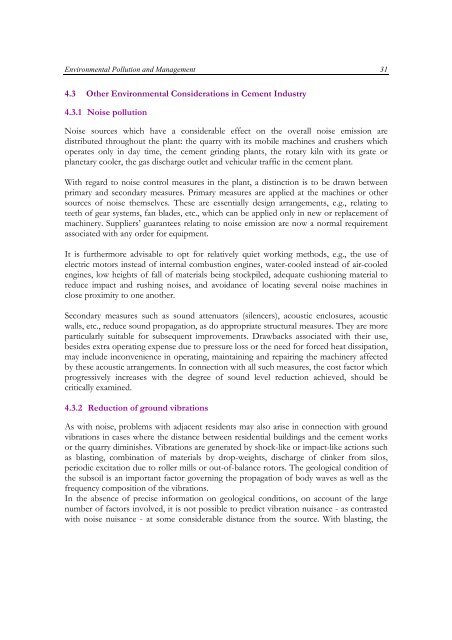technology, energy efficiency and environmental externalities in the ...
technology, energy efficiency and environmental externalities in the ...
technology, energy efficiency and environmental externalities in the ...
You also want an ePaper? Increase the reach of your titles
YUMPU automatically turns print PDFs into web optimized ePapers that Google loves.
Environmental Pollution <strong>and</strong> Management 31<br />
4.3 O<strong>the</strong>r Environmental Considerations <strong>in</strong> Cement Industry<br />
4.3.1 Noise pollution<br />
Noise sources which have a considerable effect on <strong>the</strong> overall noise emission are<br />
distributed throughout <strong>the</strong> plant: <strong>the</strong> quarry with its mobile mach<strong>in</strong>es <strong>and</strong> crushers which<br />
operates only <strong>in</strong> day time, <strong>the</strong> cement gr<strong>in</strong>d<strong>in</strong>g plants, <strong>the</strong> rotary kiln with its grate or<br />
planetary cooler, <strong>the</strong> gas discharge outlet <strong>and</strong> vehicular traffic <strong>in</strong> <strong>the</strong> cement plant.<br />
With regard to noise control measures <strong>in</strong> <strong>the</strong> plant, a dist<strong>in</strong>ction is to be drawn between<br />
primary <strong>and</strong> secondary measures. Primary measures are applied at <strong>the</strong> mach<strong>in</strong>es or o<strong>the</strong>r<br />
sources of noise <strong>the</strong>mselves. These are essentially design arrangements, e.g., relat<strong>in</strong>g to<br />
teeth of gear systems, fan blades, etc., which can be applied only <strong>in</strong> new or replacement of<br />
mach<strong>in</strong>ery. Suppliers’ guarantees relat<strong>in</strong>g to noise emission are now a normal requirement<br />
associated with any order for equipment.<br />
It is fur<strong>the</strong>rmore advisable to opt for relatively quiet work<strong>in</strong>g methods, e.g., <strong>the</strong> use of<br />
electric motors <strong>in</strong>stead of <strong>in</strong>ternal combustion eng<strong>in</strong>es, water-cooled <strong>in</strong>stead of air-cooled<br />
eng<strong>in</strong>es, low heights of fall of materials be<strong>in</strong>g stockpiled, adequate cushion<strong>in</strong>g material to<br />
reduce impact <strong>and</strong> rush<strong>in</strong>g noises, <strong>and</strong> avoidance of locat<strong>in</strong>g several noise mach<strong>in</strong>es <strong>in</strong><br />
close proximity to one ano<strong>the</strong>r.<br />
Secondary measures such as sound attenuators (silencers), acoustic enclosures, acoustic<br />
walls, etc., reduce sound propagation, as do appropriate structural measures. They are more<br />
particularly suitable for subsequent improvements. Drawbacks associated with <strong>the</strong>ir use,<br />
besides extra operat<strong>in</strong>g expense due to pressure loss or <strong>the</strong> need for forced heat dissipation,<br />
may <strong>in</strong>clude <strong>in</strong>convenience <strong>in</strong> operat<strong>in</strong>g, ma<strong>in</strong>ta<strong>in</strong><strong>in</strong>g <strong>and</strong> repair<strong>in</strong>g <strong>the</strong> mach<strong>in</strong>ery affected<br />
by <strong>the</strong>se acoustic arrangements. In connection with all such measures, <strong>the</strong> cost factor which<br />
progressively <strong>in</strong>creases with <strong>the</strong> degree of sound level reduction achieved, should be<br />
critically exam<strong>in</strong>ed.<br />
4.3.2 Reduction of ground vibrations<br />
As with noise, problems with adjacent residents may also arise <strong>in</strong> connection with ground<br />
vibrations <strong>in</strong> cases where <strong>the</strong> distance between residential build<strong>in</strong>gs <strong>and</strong> <strong>the</strong> cement works<br />
or <strong>the</strong> quarry dim<strong>in</strong>ishes. Vibrations are generated by shock-like or impact-like actions such<br />
as blast<strong>in</strong>g, comb<strong>in</strong>ation of materials by drop-weights, discharge of cl<strong>in</strong>ker from silos,<br />
periodic excitation due to roller mills or out-of-balance rotors. The geological condition of<br />
<strong>the</strong> subsoil is an important factor govern<strong>in</strong>g <strong>the</strong> propagation of body waves as well as <strong>the</strong><br />
frequency composition of <strong>the</strong> vibrations.<br />
In <strong>the</strong> absence of precise <strong>in</strong>formation on geological conditions, on account of <strong>the</strong> large<br />
number of factors <strong>in</strong>volved, it is not possible to predict vibration nuisance - as contrasted<br />
with noise nuisance - at some considerable distance from <strong>the</strong> source. With blast<strong>in</strong>g, <strong>the</strong>

















